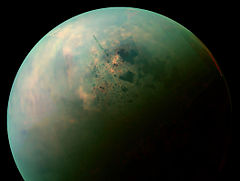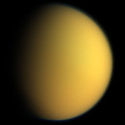Hammar Lacus
 Północna półkula Tytana w spektrum bliskim podczerwieni, widoczne jego morza i jeziora. | |
| Położenie | |
| Państwo | nie dotyczy |
|---|---|
| Region | |
| Morfometria | |
| Powierzchnia | 18 600 km² |
| Wymiary • max długość |
|
| Hydrologia | |
| Rodzaj jeziora | |
Hammar Lacus – jedno z jezior na powierzchni Tytana, największym księżycu Saturna; wypełnione płynnymi węglowodorami (głównie metanem i etanem z rozpuszczonym w nich azotem)[1]. Współrzędne obiektu wynoszą: 48.6°N 308.29°W[2]. Zbiornik ten ma 200 km długości w najdłuższym miejscu[2] i powierzchnię około 18 600 km2[3], co czyni go trzecim największym jeziorem na Tytanie.
Nazwane po irakijskim jeziorze Hammar - nazwa ta została przyjęta przez Międzynarodową Unię Astronomiczną w grudniu 2013 roku[2].
Zobacz też
Przypisy
- ↑ Athena Coustenis, F.W. Taylor, D.J. Taylor, Titan : exploring an earthlike world [eBook], wyd. 4, World Scientific Pub. Co., 2008, s. 154-155, ISBN 978-981-281-161-5.
- ↑ a b c Hammar Lacus, Gazetteer of Planetary Nomenclature, International Astronomical Union, 2013 [zarchiwizowane z adresu 2017-11-09].
- ↑ Shannon M. MacKenzie i inni, Evidence of Titan’s climate history from evaporite distribution [PDF], Icarus, 2014, DOI: 10.1016/j.icarus.2014.08.022.
Media użyte na tej stronie
This natural color composite was taken during the Cassini spacecraft's April 16, 2005, flyby of Titan. It is a combination of images taken through three filters that are sensitive to red, green and violet light. It shows approximately what Titan would look like to the human eye: a hazy orange globe surrounded by a tenuous, bluish haze. The orange color is due to the hydrocarbon particles which make up Titan's atmospheric haze. This obscuring haze was particularly frustrating for planetary scientists following the NASA Voyager mission encounters in 1980-81. Fortunately, Cassini is able to pierce Titan's veil at infrared wavelengths (see PIA06228). North on Titan is up and tilted 30 degrees to the right. The images to create this composite were taken with the Cassini spacecraft wide angle camera on April 16, 2005, at distances ranging from approximately 173,000 to 168,200 kilometers (107,500 to 104,500 miles) from Titan and from a Sun-Titan-spacecraft, or phase, angle of 56 degrees. Resolution in the images is approximately 10 kilometers per pixel. The Cassini-Huygens mission is a cooperative project of NASA, the European Space Agency and the Italian Space Agency. The Jet Propulsion Laboratory, a division of the California Institute of Technology in Pasadena, manages the mission for NASA's Science Mission Directorate, Washington, D.C. The Cassini orbiter and its two onboard cameras were designed, developed and assembled at JPL. The imaging team is based at the Space Science Institute, Boulder, Colo. For more information about the Cassini-Huygens mission, visit http://saturn.jpl.nasa.gov and the Cassini imaging team home page, http://ciclops.org.
Mapa powierzchni Tytana, bez ramki i zmniejszona w celu użycia w szablonach, przede wszystkim lokalizacyjnych. Mapa przedstawia stan wiedzy z grudnia 2018 roku.
Autor: Tzugaj, Licencja: CC0
znak graficzny do map, ukazujący przykładowe jezioro
This false-color mosaic, made from infrared data collected by NASA's Cassini spacecraft, reveals the differences in the composition of surface materials around hydrocarbon lakes at Titan, Saturn's largest moon. Titan is the only other place in the solar system that we know has stable liquid on its surface, though its lakes are made of liquid ethane and methane rather than liquid water. While there is one large lake and a few smaller ones near Titan's south pole, almost all of Titan's lakes appear near the moon's north pole.
Scientists mapped near-infrared colors onto the visible color spectrum. Red in this image was assigned a wavelength of 5 microns (10 times longer than visible light), green 2.0 microns (four times longer than visible light), and blue 1.3 microns (2.6 times longer than visible light).
The orange areas are thought to be evaporite -- the Titan equivalent of salt flats on Earth. The evaporated material is thought to be organic chemicals originally from Titan's haze particles that once dissolved in liquid methane. They appear orange in this image against the greenish backdrop of Titan's typical bedrock of water ice.
In this mosaic, Kraken Mare, which is Titan's largest sea and covers about the same area as Earth's Caspian Sea and Lake Superior combined, can be seen spreading out with many tendrils on the upper right,. The big dark zone up and left of Kraken is Ligeia Mare, the second largest sea. Below Ligeia, shaped similar to a sports fan's foam finger that points just up from left, is Punga Mare, the third Titan Sea. Numerous other smaller lakes dot the area. Titan's north pole is located in the geographic location just above the end of the "finger" of Punga Mare.
An annotated version of this image, with a high-resolution strip highlighted, is also available. In this version, the north pole is marked with a red cross and other smaller lakes are also labeled.
The data shown here were obtained by Cassini's visual and infrared mapping spectrometer during a close flyby of Titan on Sept. 12, 2013.
Until now, the spectrometer has only been able to capture distant, oblique or partial views of this area until now. The Sept. 12, 2013 flyby provided better viewing geometry. And sunlight has begun to pierce the winter darkness that shrouded Titan's north pole at Cassini's arrival in the Saturn system nine years ago. A thick cap of haze that once hung over the north pole has also dissipated as northern summer approaches. And, thankfully, Titan's beautiful, almost cloudless, rain-free weather continued during this flyby.
The resolution varies across this composite view depending on when each cube of data was acquired, but the best surface sampling is 2 miles (3 kilometers) per pixel.
Views of this area by other Cassini instruments include PIA17471, PIA17472, PIA17473 and PIA14584 from the imaging science subsystem; and PIA10008 and PIA17031 from the radar mapper. An earlier VIMS view can be seen at PIA16845.
The Cassini-Huygens mission is a cooperative project of NASA, the European Space Agency and the Italian Space Agency. The Jet Propulsion Laboratory, a division of the California Institute of Technology in Pasadena, manages the Cassini-Huygens mission for NASA\'s Science Mission Directorate, Washington, D.C. The imaging team consists of scientists from the US, England, France, and Germany. The visual and infrared mapping spectrometer team is based at the University of Arizona. The imaging operations center and team lead (Dr. C. Porco) are based at the Space Science Institute in Boulder, Colo.
For more information about the Cassini-Huygens mission, visit http://saturn.jpl.nasa.gov and the Cassini imaging team home page, http://ciclops.org.
The original NASA image has been cropped, and borders were added. Some of the features in this image have been annotated in Wikimedia Commons.




